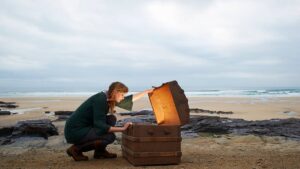Back to the future: Small-cap goldies revisit abandoned riches in WA’s outback

The high price environment for gold is prompting ASX companies to reexamine brownfields projects for new discoveries. Pic: Getty Images
- Brownfield exploration is based on the theory that the best place to find a gold mine is underneath an old one
- The robust gold market has sparked renewed interest in these hidden gems and overlooked areas
- Here are some ASX success stories and a few of the juniors following in the footsteps
With gold prices at historical highs and rising, previously popular exploration trends are beginning to make a comeback among ASX junior companies looking to leverage their projects and strike while gold is hot.
One such trend is the shift towards picking up distressed gold assets in the hopes of giving them a new lease of life and moving the project closer to production.
Different to greenfield exploration, where companies explore for entirely new orebodies, brownfield exploration is based on the theory that the best place to find a gold mine is underneath an old one.
Many discoveries have been made ‘in the shadow of a headframe’ – areas that were mined before but due to logistics, technology, capital allocation or low metal prices were left undiscovered, even though they were right under the nose.
Big miners and success stories
The poster child for that concept is ASX 50 gold miner Northern Star Resources (ASX:NST), which has invested $125 million a year in exploration mainly around mines which are already producing and have done so for decades, including Kalgoorlie’s famous Super Pit.
Another was Mincor Resources (ASX:MCR), which collected most of the ground once held by Western Mining Corporation before it sold off the Kambalda nickel mines that made it famous at the turn of the century. While the nickel market has seen better days, Mincor nabbed a major payday for investors with a $760 million sale to Andrew Forrest’s Wyloo Metals.
There are many different reasons companies decide to pick up an old asset, but one of the main ones – apart from the convenient established infrastructure – is the opportunity to extend the existing life of a historical high-grade mine by finding new, previously untouched deposits.
Every once in a while, these neglected areas prove to hold impressive discoveries when looked at a little more closely, as was the case for Spartan Resources (ASX:SPR) and the lucky encounter of the Never Never deposit at Dalgaranga.
From just 79,600oz and slightly under 3.8g/t in 2022, Never Never turned into today’s 5.72Mt monster at 8.07g/t for a whopping 1.49Moz of contained gold simply because the then new CEO and former Northern Star senior geo Simon Lawson decided to halt production and change the company’s exploration approach.
Lawson made the call to turn the drill rigs in a different direction in the low-grade Gilbeys greenstone belt and started to reel in hits of up to 59m grading 12.5g/t, 54m grading 6.55g/t and 32m grading 8.58g/t.
Another small-cap success story is Auric Mining (ASX:AWJ), the owners of tenements smack back in the middle of Kalgoorlie and Norseman in WA’s prolific Goldfields.
Auric picked up an existing gold inventory of more than 220,000 ounces when it listed in February 2021 with its Widgiemooltha project.
The company’s Munda deposit exceeds grades of 2g/t at a 0.5g/t cut-off, which once mined, would be hauled to a nearby mill for toll treating.
A scoping study in mid-2023 envisaged extracting between 112,000 and 129,000 ounces of gold from the project over a three to five-year mine life and suggested a free cash surplus for the project to be $77 million based on a gold price of $2,600 an ounce.
Planning is now well advanced to begin shallow, open pit mining in Q4 2024 or Q1 2025 before expanded mining from 2025 onwards.
Auric’s Spargos project is also located in a top shelf address between two historical mines including the Spargos Reward mine near Kambalda WA. Spargos Reward, 3km north of Auric’s ground, was notable for producing 131,000oz of gold at a grade of 4.3g/t in the 1930’s. Another 2km to the south, Ramelius Resources mined the Wattle Dam deposit in the 2000’s, producing 267,000oz of gold at 10.6g/t.
The company recently defined a mineralised zone within an 80m wide basalt running along the spine of the Fugitive prospect and opened up a new target at Anomaly 37.
Juniors following in the footsteps
Javelin Minerals (ASX:JAV) is now looking to replicate this success with the start of Phase One reverse circulation drilling totalling ~2500m at its Coogee project.
Despite sitting next to the world-class St Ives Goldfield and hosting an existing resource of 3.65Mt at 1.08g/t gold for 126,685oz of contained gold and 1.01Mt at 0.41% copper, or 4133t of the red metal, the previously mined project has not seen a systematic exploration drilling campaign since Ramelius Resources (ASX:RMS) completed mining in 2014.
Results from Phase One will be interpreted before the company kicks off Phase Two drilling in late January.
Both phases of drilling are looking to confirm potential extensions to mineralisation below the current mined pit level at the Coogee deposit as it has not been closed off at depth.
It will also test the north-west trending shear, which is parallel to the Coogee Shear zones that hosted the high-grade gold mined by RMS, the Coogee South prospect where historical aircore drilling hit shallow mineralisation, and the strong magnetic “Bulls-Eye” target (CG-01) 300m north of the Coogee Pit.
JAV also scooped up the past producing Eureka gold mine for $3m just last month, joining into a new boom of brownfields exploration around the Kalgoorlie gold capital.
The asset did not fit into the Delta Lithium (ASX:DLI) ambitions toward white gold, but Javelin was more than happy to dig into a play for traditional ounces currently trading beyond US$2600 a pop.
Re-processing of aeromagnetic survey data at the brownfields Eureka gold project has unearthed at least a dozen structural and geochemical targets, which JAV says warrant an immediate follow-up northbound from Kalgoorlie.
Some of the quarry sits immediately along strike from the project’s namesake deposit, currently holding a collection of 112,000oz on a granted licence in mineralisation which remains open along strike and at depth.
And Black Cat Syndicate (ASX:BC8) is off to the races and on track to achieve a production rate of +70,000ozpa from two assets by mid-2025, one of them being the historical Paulsens mine which it bought – along with the Coyote mine – off Northern Star in 2022 for $44m.
What Northern Star saw as surplus to requirements, Black Cat saw as an opportunity.
Drilling at Paulsens has yielded some very high-grade gold hits up to an eye watering 64.1g/t gold outside the mine plan, supporting the restart study released in May 2024.
The results of the study showed operating cashflow before tax increased by 81% to $201m with an unchanged mine life of 4.2 years.
Paulsens itself also remains open for growth potential from numerous high-grade veins outside the current 406,000z resource at 9.5g/t gold that if developed, could build a stockpile for immediate processing once the facility is commissioned.
At Stockhead we tell it like it is. While Spartan Resources and Javelin Minerals are Stockhead advertisers, they did not sponsor this article.
UNLOCK INSIGHTS
Discover the untold stories of emerging ASX stocks.
Daily news and expert analysis, it's free to subscribe.
By proceeding, you confirm you understand that we handle personal information in accordance with our Privacy Policy.








